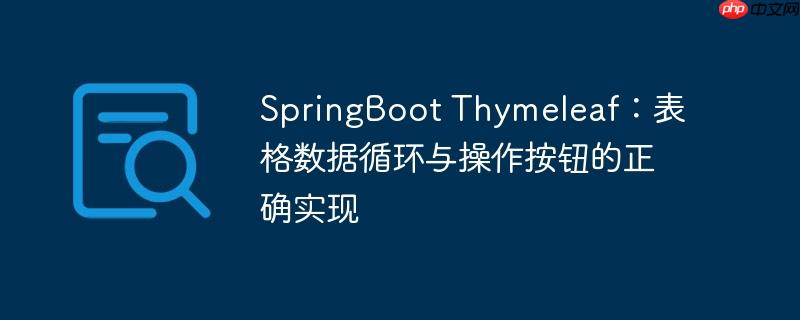
在 web 应用开发中,我们经常需要在前端页面以表格形式展示后端数据,并为每条数据提供诸如“删除”、“编辑”等操作按钮。然而,在 thymeleaf 中处理这类需求时,如果对循环机制理解不当,很容易出现按钮重复渲染或数据错位的问题。本教程将深入探讨如何正确地实现这一功能,确保数据与操作按钮一一对应。
许多初学者在 Thymeleaf 中循环展示数据时,可能会尝试分别循环不同的数据列表(例如,一个 descriptionList 和一个 idList),并试图将它们组合在同一行中。当需要为每行添加一个操作按钮时,如果再次对 ID 列表进行循环,就会导致按钮数量与 ID 列表的长度成倍增加,而非每行一个。
原始问题示例(错误示范):
<table>
<tr th:each="description : ${descriptionList}">
<td th:text="${description}"> </td>
<td th:each="id : ${idList}"> </td> <!-- 第一次错误:在此处循环idList -->
<td th:text="${id}"> <!-- 此处id的值可能不确定或与description不匹配 -->
<td th:each="id : ${idList}"> <!-- 第二次错误:再次循环idList以添加按钮 -->
<form action="/deletewish" method="post">
<input type="hidden" name="email" th:value="${email}">
<input type="hidden" name="wish_id" th:value="${id}">
<button type="submit"> Delete </button>
</form>
</td></td>
</tr>
</table>上述代码的问题在于,外部 <tr> 已经对 descriptionList 进行了循环。内部的 <td> 元素中又嵌套了对 idList 的循环。这会导致每个 description 都会匹配 idList 中的所有 id,从而产生大量重复的 <td> 元素和操作按钮,与期望的“每行一个描述、一个 ID 和一个删除按钮”相去甚远。
解决上述问题的关键在于统一数据模型。我们不应该在 Thymeleaf 模板中尝试将多个独立的列表拼接起来,而应该在后端将相关联的数据封装成一个统一的 Java 对象列表。每个对象代表表格中的一行数据,包含该行所需的所有信息(如描述、ID、邮箱等)。
示例:定义一个数据模型类
假设我们需要展示用户 ID、邮箱和一些其他信息,并为每个用户提供删除功能。我们可以定义一个 User 类来封装这些信息:
public class User {
private Long id;
private String email;
// 可以添加其他属性,例如 description
private String description;
// 构造函数
public User(Long id, String email, String description) {
this.id = id;
this.email = email;
this.description = description;
}
// Getter 和 Setter 方法
public Long getId() {
return id;
}
public void setId(Long id) {
this.id = id;
}
public String getEmail() {
return email;
}
public void setEmail(String email) {
this.email = email;
}
public String getDescription() {
return description;
}
public void setDescription(String description) {
this.description = description;
}
}在 Spring Boot 控制器中,我们需要创建一个 User 对象的列表,并将其添加到 Model 中,以便 Thymeleaf 模板可以访问。
示例:Spring Boot Controller
import org.springframework.stereotype.Controller;
import org.springframework.ui.Model;
import org.springframework.web.bind.annotation.GetMapping;
import org.springframework.web.bind.annotation.PostMapping;
import org.springframework.web.bind.annotation.RequestParam;
import java.util.ArrayList;
import java.util.List;
@Controller
public class UserController {
// 模拟数据存储
private List<User> userList = new ArrayList<>();
public UserController() {
// 初始化一些模拟数据
userList.add(new User(1L, "user1@example.com", "Description for User 1"));
userList.add(new User(2L, "user2@example.com", "Description for User 2"));
userList.add(new User(3L, "user3@example.com", "Description for User 3"));
}
@GetMapping("/users")
public String showUsers(Model model) {
model.addAttribute("users", userList); // 将用户列表添加到模型
return "userList"; // 返回 Thymeleaf 模板名称
}
@PostMapping("/user/delete")
public String deleteUser(@RequestParam("id") Long userId) {
userList.removeIf(user -> user.getId().equals(userId));
// 可以添加日志或重定向到其他页面
return "redirect:/users"; // 删除后重定向回用户列表页面
}
}在 showUsers 方法中,我们创建了一个 User 对象的 List,并将其命名为 users 添加到 Model 中。Thymeleaf 模板将通过这个名称来访问数据。
现在,我们可以在 Thymeleaf 模板中编写正确的循环逻辑,为每行数据展示信息并提供一个独立的操作按钮。
示例:userList.html
<!DOCTYPE html>
<html lang="en" xmlns:th="http://www.thymeleaf.org">
<head>
<meta charset="UTF-8">
<title>用户列表</title>
<style>
table {
width: 100%;
border-collapse: collapse;
}
th, td {
border: 1px solid black;
padding: 8px;
text-align: left;
}
th {
background-color: #f2f2f2;
}
</style>
</head>
<body>
<h1>用户管理</h1>
<table>
<thead>
<tr>
<th>ID</th>
<th>邮箱</th>
<th>描述</th>
<th>操作</th>
</tr>
</thead>
<tbody>
<!-- 使用 th:each 循环遍历整个用户列表 -->
<tr th:each="user : ${users}">
<td th:text="${user.id}"></td> <!-- 显示用户ID -->
<td th:text="${user.email}"></td> <!-- 显示用户邮箱 -->
<td th:text="${user.description}"></td> <!-- 显示用户描述 -->
<td>
<!-- 为每个用户创建一个独立的删除表单 -->
<form th:action="@{/user/delete}" method="post">
<!-- 隐藏字段传递用户ID -->
<input type="hidden" name="id" th:value="${user.id}">
<button type="submit">删除</button>
</form>
</td>
</tr>
</tbody>
</table>
</body>
</html>代码解析:
通过这种方式,th:each 循环确保了每迭代一个 User 对象,就会生成一个完整的 <tr>(一行),其中包含该用户的所有信息以及一个专门用于删除该用户的表单和按钮。这样就完美解决了按钮重复渲染的问题,并实现了数据与操作的一一对应。
在 Spring Boot 和 Thymeleaf 中实现表格数据循环展示及操作按钮功能,关键在于采用统一的数据模型和正确的循环结构。通过在后端将相关数据封装为对象列表,并在 Thymeleaf 模板中使用 th:each 对该列表进行单次迭代,我们能够确保每行数据都拥有清晰的展示和对应的操作功能,从而避免常见的渲染错误,构建出高效且用户友好的 Web 界面。
以上就是SpringBoot Thymeleaf:表格数据循环与操作按钮的正确实现的详细内容,更多请关注php中文网其它相关文章!

每个人都需要一台速度更快、更稳定的 PC。随着时间的推移,垃圾文件、旧注册表数据和不必要的后台进程会占用资源并降低性能。幸运的是,许多工具可以让 Windows 保持平稳运行。

Copyright 2014-2025 https://www.php.cn/ All Rights Reserved | php.cn | 湘ICP备2023035733号